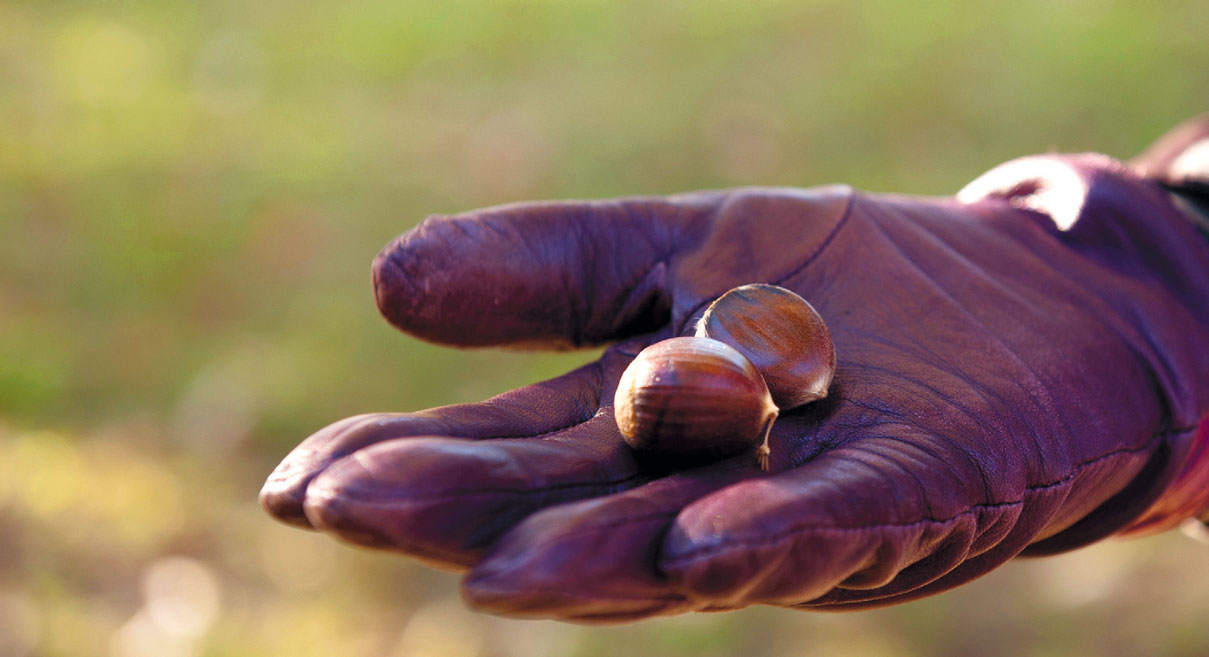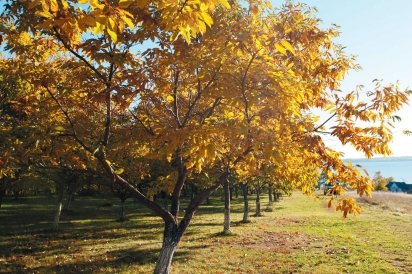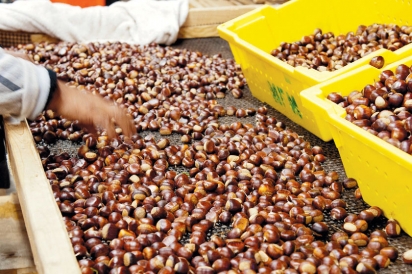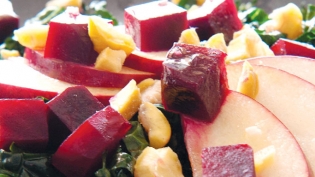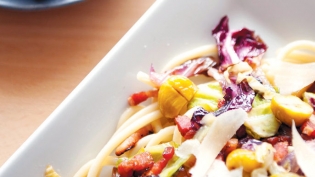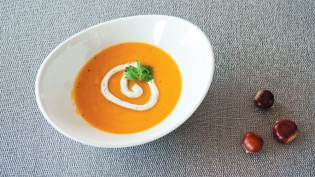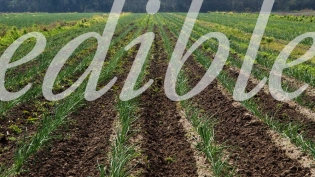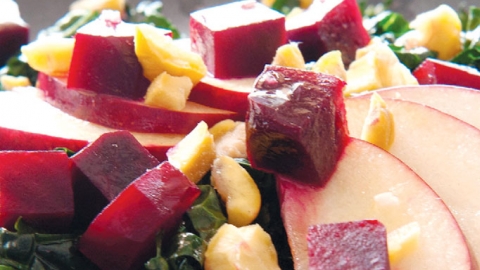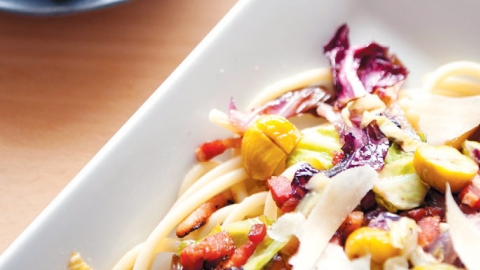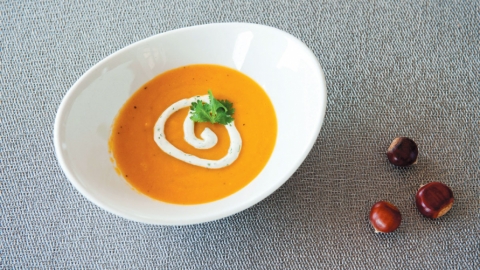The Chestnut Enigma
Once a staple in America, this underappreciated delicacy is just now beginning to come out of its shell again.
Had Henry Wadsworth Longfellow been under that fabled spreading chestnut tree at night, rather than during the day, at harvest time back in 1840, he might have written quite a different poem. Instead of observing the village blacksmith swinging his hammer noisily against the anvil, Longfellow would have encountered all manner of forest fauna—deer, raccoons, squirrels, chipmunks—going about their own work: gathering and eating every single chestnut on the ground before stealing back into the woods until the sweet aroma and plop, plop, plop of the next day’s nutfall beckoned them back.
“If we don’t get to the chestnuts first, the animals will literally decimate the crop,” says Ella Cooper, project manager and marketing director for Croft Chestnuts in Traverse City. “The deer are incredible—they don’t even mind if the nuts are still in the burrs; they’ll eat them, burr and all. The burrs are nature’s way of protecting the chestnuts. They’re so spiky that humans can’t touch them without heavy leather gloves. So you can only imagine how tough the tongues and mouths of deer must be!
“When the chestnuts are starting to ripen, you’ll often see branches broken off, too. Sometimes that’s due to wind, but more often it’s a raccoon who has ventured to the end of the limb, where the chestnut clusters grow, to secure his prize, and his body weight can bring it down.”
Apparently, those wild creatures are more food-savvy than most Americans, who—if they eat chestnuts at all—limit their consumption of this healthy, delectable treat to the stuffing for their holiday turkey or goose. In Europe, Asia and parts of the Middle East, however, chestnuts are abundant and prized. Cooper, who is originally from Stoke-on-Trent, just north of London, says they can be found bagged in the frozen-food section of grocery stores in the UK, right next to the corn and lima beans, any time of year.
“I grew up eating a lot of them,” she adds.
Worldwide, chestnut recipes abound. A dessert of cooked and puréed chestnuts and rum or brandy, topped with whipped cream, is a favorite both on restaurant menus and on home tables in Switzerland, Italy and France, where it is called, respectively, Vermicelles, Monte Bianco or Mont Blanc. The Swiss also make beer and jam out of chestnuts; the French use them to create fancy pastries (among them the iconic chestnut cream-filled Bûche de Noël); and Italians put them in soups, combine them with sausage or mushrooms for pasta sauces, or make gelato out of them. Chicken with chestnuts (not to be confused with water chestnuts, which are unrelated) is a common Chinese dish, while Middle Eastern cooks may braise them with lamb and pungent spices and serve the stew-like mixture over rice.
The chestnut is unique in that, unlike other nuts, it is a starch—more like a grain than a nut, except that it grows on trees in an orchard. Thus, in addition to its whole and puréed applications, it can be ground into flour and used for cakes, biscuits and cookies. It’s also gluten- and cholesterolfree. Nutritionally, the benefits of chestnuts are well documented: High in complex carbohydrates, protein and fiber; low in fat; and rich in vitamins and minerals, they are a healthy addition to any diet. And as if those attributes weren’t enough to recommend them, they also taste sweet and delicious, even raw.
REESTABLISHING THE CROP
So what’s keeping them from becoming the next big thing for American palates? According to Cooper, limited availability is one factor. “The crop shows up for a very short period of time—from October to perhaps the end of November or early December—and then it’s gone. Finding chestnuts in anything but their fresh state is a challenge in the United States.”
And then there’s the fact that the chestnut has had to overcome incredible odds to survive in this country at all. “There is a rich history of chestnuts in America—one that had a very unfortunate turn of events at the beginning of the 20th century,” says Cooper. “Chestnut blight hit the East Coast in 1904. It spread and eventually eradicated nearly all of America’s majestic chestnut trees.” About four billion trees were lost, and with them not only a valuable source of food, but also a decayresistant wood that had been important to the American economy at the time.
“The American chestnut has been repopulated, and there is a great effort to reestablish it as a viable nut-producing tree,” says Cooper, “but it’s a long and rather precarious path, because the fungus is still ubiquitous here, and the tree is still susceptible to it.”
Among the staunchest supporters and promoters of that effort—and of the edible chestnut industry as a whole—are Michigan State University and the American Chestnut Tree Foundation, located in North Carolina.
“MSU is very helpful to all orchards that are growing chestnuts in Michigan,” says Cooper. She has been fortunate to work directly with Dennis Fulbright, PhD, a plant pathologist and professor emeritus at MSU’s Department of Plant, Soil and Microbial Sciences, who has long been a committed champion of the cause of chestnuts and those who grow them.
“He’s a major force in trying to get the chestnut industry back on its feet,” says Cooper. Fulbright also works with MSU’s Rogers Reserve in Jackson, Michigan, a 100-acre agricultural research station dedicated to growing and studying chestnuts; and serves as university advisor to the Michigan Nut Growers Association, the MSU-affiliated Midwest Nut Producers Council, and Chestnut Growers, Inc. (CGI). The latter is an agricultural marketing cooperative based near Lansing with 30-plus members.
GROWING PAINS
Chestnut growing is not for sissies. It is dirty, tiring, physical work—and add cold and wet to that during harvest season. Just ask Ella Cooper. Her regular “business attire” consists of trousers, a warm waterproof jacket, thick gloves and sturdy boots. She thinks another factor hindering the chestnut from achieving widespread popularity is the manual labor required not only for growing, harvesting and sorting, but also for peeling.
“Peeling equipment would be great to have, but it’s neither readily available nor affordable for small-scale chestnut growers,” she says. The Italian-made commercial chestnut peeling line at Rogers Reserve, which was partially funded by the USDA Rural Development program, is the only one of its kind in the Western Hemisphere.
It’s a tricky crop, too. Chestnuts like an acidic soil with a pH of somewhere around 5.3 to 5.8. “You can amend it with nutrients, but you will never win the battle,” says Cooper. “Mother Nature will always try to keep the soil the way it is.” The trees must also be planted far enough apart for their canopy to spread and still allow sufficient light to get to every branch for optimum development of the nuts. And, as with all crops, yields are influenced by weather conditions, including frost, rain (or, better said, lack of it) and wind.
Things may be looking up for chestnuts, however—in our neck of the woods, at least. In December 2014, the Detroit News reported that Michigan leads the nation in the number of chestnut trees and farms, producing over 100,000 pounds annually. In the same article, CGI president Roger Blackwell predicted that number will more than double in just five years; in 10, it is likely to quadruple. Most Michigan chestnut growers—over 110 at last count—are located in the “fruit belt” on the western side of the state. With improved growing, marketing and production practices, as well as new uses being discovered (chestnut beer, anyone?), demand for chestnuts is slowly but steadily increasing. Croft’s Cooper says her inventory sells out every year now, and her customer base includes buyers from as far away as California and Arizona.
THE NEXT BIG THING
Restaurant chefs have been on to the versatility of seasonal cooking with chestnuts for quite a while. Myles Anton, at Trattoria Stella in the Village at Grand Traverse Commons, offers roasted, salted chestnuts (from Croft) in a bag as an appetizer every year around the holidays. This year he is also creating a chestnut dish at his other restaurant, the Franklin, in downtown Traverse City. Hermann Suhs, of Hermann’s European Café in Cadillac, serves leg of venison with chestnuts and wild boar with chestnuts as specials during fall and winter. Special menu items using chestnuts will also be featured by Guillaume Hazaël Massieux at La Becasse in Burdickville as they become available.
How can growers boost enthusiasm for chestnuts and get people thinking of them as a seasonal staple? Sometimes all it takes is just one bite, as Blackwell noted in a Detroit Metro Times article earlier this year. CGI roasts chestnuts and samples them at Detroit’s Eastern Market during November and December each year. Half the people who try them have never tasted a chestnut, says Blackwell, and most are surprised at how much they like them.
Beneath the burr-laden chestnut trees in Croft’s McKian orchard overlooking East Bay on a misty day in early October, an aura of enchantment fills the grove—as if not deer or raccoons, but rather elves and fairies, might appear at any moment. It’s a magical place, echoing the magic that will soon happen here when the beautifully smooth and shiny, sweet delicacies that are chestnuts rain down to the ground out of their dangerously spiny, unfriendly husks. An end and a new beginning, all at once—perhaps this time enticing a whole new host of admirers to discover what the magic is all about.
CROFT CHESTNUTS
Croft Chestnuts, owned by Villa Mari Vineyards’ Marty Lagina, maintains two orchards in Traverse City—McKian (pronounced “ma-kai-en”), on Old Mission Peninsula, with about 900 trees; and Long Lake, just west of town, with about 500 trees—making it one of the largest commercial chestnut producers in Northern Michigan. The trees in Croft’s orchards are almost all Chinese chestnuts, Castanea mollissima, a hardy species that is highly resistant to blight. In 2014, the Croft sorting facility on Center Road processed about 6,000 pounds of chestnuts from the two orchards. (Find more information, including storage tips, cooking methods, sales and recipes, at CroftChestnuts.com.)
WHERE TO BUY CHESTNUTS
Confirm availability in advance during the season, and also check with other local retailers, markets and restaurants.
Retail:
Farmers’ market vendors
Burritt’s Market, Traverse City, 231-946-3300
Evergreen Market, Acme, 231-342-3994
Friske Orchards, Atwood, 231-599-2604
Grain Train Co-op, Petoskey, 231-347-2381
Hansen Foods, Suttons Bay 231-271-4280
Oryana Co-op, Traverse City, 231-947-0191
Peninsula Market, Traverse City, 231-223-9500
Online:
Earthy Delights (fresh, peeled and frozen chestnuts and recipes)
Chestnut Growers, Inc. (all of the above, plus chestnut flour and recipes; also general information about chestnuts)


